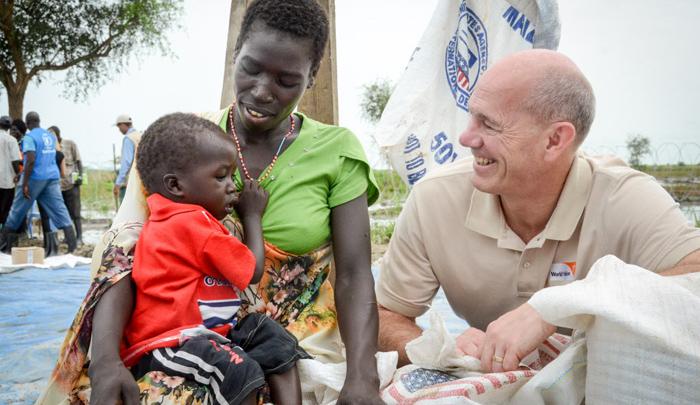
Monrovia, CA (October 10, 2014) — South Sudan’s food insecurity crisis hasn’t worsened to the point of famine, but the threat still looms large with meager crops potentially only delaying life-threatening hunger.
The latest analysis of South Sudan’s food security by the IPC (Integrated Food Security Phase Classification, tools that classify food security) found the availability of and access to food hasn’t deteriorated to the point of famine, even in some of the regions hit hardest by recent conflict and floods. But famine is a long-term condition that could still loom over the world’s youngest nation if October’s crops are much smaller than in previous years. The IPC report credited ongoing humanitarian assistance with averting a worse situation.
The fighting that has plagued the country since December prevented farmers from planting seeds or forced them off their land after planting. Severe floods during the rainy season have exacerbated the problem, and conditions may potentially worsen early next year when the small volume of harvest runs out, long before next year’s harvest.
World Vision South Sudan Program Director Perry Mansfield said even if there were some crops to harvest in October, the four million South Sudanese facing food insecurity were still in very real need, while the United Nations has warned that 50,000 children may die by 2015.
“When we get distracted by language and trying to define a problem in abstract percentages we can forget that every night more people than the population of the city of Los Angeles go to sleep hungry,” Mansfield said.
“Among them are children, pregnant women and the elderly, and it’s tempting to think everything will be fine because we haven’t reached famine conditions, but these people are in crisis and if we act early and act fast we can save lives.“
A famine is declared when at least 20% of households in an area face extreme food shortages with a limited ability to cope; acute malnutrition rates exceed 30%; and the death rate exceeds two people per day for every 10,000.
Mansfield said it is a race against time to help people re-establish their livelihoods and means of production before those sobering conditions are met.
“South Sudan needs peace, it needs all parties to the conflict to stop fighting, it needs to allow aid workers and relief supplies unimpeded access — and it needs the world to care enough to step in now, before we see a repeat of the 260,000 dead in the 2011 Somalia famine,” Mansfield said, “more of whom died before famine was even declared than after.”
World Vision has been carrying out regular food distributions across the worst-hit states, but continued fighting jeopardizes humanitarian access and can make delivery of aid to those who need it most uncertain.
“Hunger can be a slow-burning enemy,” Mansfield said. “It can outlast violence and instability, and take a long time to claim its victims. The only way to counter it is to ensure stable and constant food availability as soon as possible.”
World Vision can provide one person with two weeks’ worth of food for $22.
For more information or to arrange an interview with Mansfield, please contact Kate Rose at +211.9240.564.35 or +61.428.528.683.
– END –
About World Vision:
World Vision is a Christian humanitarian organization conducting relief, development, and advocacy activities in its work with children, families, and their communities in nearly 100 countries to help them reach their full potential by tackling the causes of poverty and injustice. World Vision serves all people regardless of religion, race, ethnicity, or gender. For more information, please visit www.WorldVision.org/media-center/ or on Twitter @WorldVisionUSA.
Highlights
- South Sudan’s food insecurity crisis hasn’t worsened to the point of famine, but the threat still looms large with meager crops potentially only delaying life-threatening hunger.
- World Vision has been carrying out regular food distributions across the worst-hit states, but continued fighting jeopardizes humanitarian access.
- World Vision can provide one person with two weeks’ worth of food for $22.